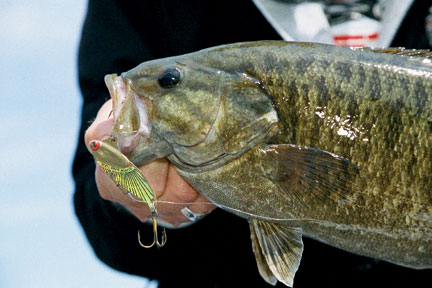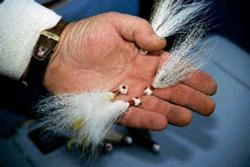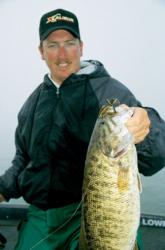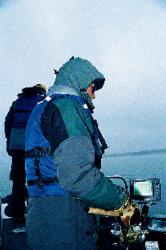Chilly smallmouths
Cold water can mean hot bites

Throughout the Southern Smallmouth Belt, the chilled waters of late fall and early winter can bring the promise of a trophy bronzeback bite.
Wal-Mart FLW Tour Pro Bill Chapman of Salt Rock, W.Va., is a smallmouth addict, with his passion for brown bass continuing well past the tournament season. His largest smallmouth – more than 7 pounds – came from Dale Hollow Lake during winter drawdown.
Wal-Mart FLW Series pro Jimmy Mason also turns to smallmouths when the tournament season comes to an end. The Alabama angler’s personal best of 7 1/2 pounds came from Pickwick Lake during the coldwater period.
Perfect smallmouth scenario
Chapman, who primarily fishes highland reservoirs for smallies, acknowledged it is a different ball game, in terms of location and presentation, during the coldwater period than in summer.
“First off, on the flood-control reservoirs of West Virginia, eastern Kentucky and eastern Tennessee, the drawdown is generally severe – anywhere from 30 to 70 feet,” Chapman said. “The locations you were fishing in the spring and summer are high and dry. The winter drawdown concentrates baitfish and smallmouths in the deeper sections of the lake, which is basically the lower third of the impoundment. This time of year, if I venture up a creek arm, it’s only a short distance.”
During the initial stage of the coldwater period, Chapman focuses his efforts on steep (but not vertical) banks with a bottom mixture of gravel and clay. Once water temperatures drop into the upper 40s, he moves to more vertical rock banks that include ledges and bluff walls.
“Ideally, I like to find a combination bank – a tapered gravel slope out to the 15- or 20-foot depth range – that changes into a rocky bluff or shale ledge wall that falls into much deeper water,” Chapman explained.
“I also fish the Ohio River for smallmouths in the winter,” Chapman continued. “Surprisingly, you can catch some respectable smallies from the Ohio, particularly in the Parkersburg pool. Granted, a 5-pounder is a big fish for the river, but I get a lot of 3- and 4-pounders.”
Chapman said finding smallmouths in the river is easier than searching for them in a reservoir.
“Most of the decent smallmouths will be stacked up on hard spots in eddy holes at the mouths of the tributary creeks,” he said. “The bait and bass are looking to get out of the stronger river current, so it’s to creek mouths they go. The problem is this: You have to go through a lot of saugers to catch the smallmouths. Then again, catching saugers all day long isn’t so bad!”
Take a buddy fishing
Chapman relies on two lures for the coldwater period in both reservoirs and rivers. His first pick is an old Kentucky lure with a national reputation – the Silver Buddy. His second pick also has a long tradition – a hair jig.
“The Silver Buddy is my No. 1 cold-water smallmouth bait, hands down,” Chapman said. “It does not look like much, but a guy can really catch fish on it when the water temperature is below 50 degrees.
“One day, a friend and I caught 50 smallmouths over 4 pounds on the Buddy – in 42-degree water! The coldest water temp that I’ve taken smallmouths on the Buddy was 34 degrees. But many people who try the Silver Buddy do not catch bass with it because they overwork it.”
The Sliver Buddy is a thin, teardrop-shaped, metal fin with a dab of lead molded to the bottom edge and a line-tie on the top edge. When pulled through the water, it vibrates like crazy. It is available in 1/4-, 1/2-, 3/4- and 1-ounce sizes with several different finishes.
Chapman employs the 1/2-ounce model 90 percent of the time, and always chooses the original, plain metal, silver finish. He ties a plain, round-bend, cross-lock snap to his line; then he attaches the Buddy to the snap. “That’s it – one snap, not a snap-swivel or other extra hardware to foul it up,” he stressed.
Chapman chooses a 6 1/2- or 7-foot medium-heavy casting rod with 10-pound line for blade fishing.
“The shallowest I fish the Silver Buddy is 10 feet, “Chapman said. “How deep I fish it depends on the structure. I’ve caught smallies with it down to 40 feet; but most of the time fishing below 30 feet in the wintertime for smallmouths is not productive.”
Now for the retrieve technique: With his boat positioned over deep water, Chapman throws the Buddy toward the bank into 10 or 15 feet of water. Once the lure settles to the bottom, he takes up slack and uses his rod tip to lift the Buddy off the bottom. He raises the lure only until he feels it begin to vibrate. He pauses momentarily and then begins to lower the rod tip at the same speed the Buddy is sinking. When it touches bottom, he lifts the rod tip again.
“It’s that simple: just pick it up and set it back down,” Chapman explained. “You do not want to snap the lure or raise it too far off the bottom, and never drop the rod tip too quickly; otherwise line will loop around the hooks.”
 If the blade isn’t producing, Chapman turns to a 1/8-ounce white bucktail jig, especially when fishing the river. He ties his own on hand-poured jigheads with a 2/0 hook. For delivering jigs, he relies on a 6 1/2-foot, medium-heavy, fast-tip spinning rod with 6- or 8-pound-test line.
If the blade isn’t producing, Chapman turns to a 1/8-ounce white bucktail jig, especially when fishing the river. He ties his own on hand-poured jigheads with a 2/0 hook. For delivering jigs, he relies on a 6 1/2-foot, medium-heavy, fast-tip spinning rod with 6- or 8-pound-test line.
“Nothing looks more like a minnow than the slow undulation of long hair on a bucktail jig,” Chapman said. “Throw the jig into 12 or 15 feet of water and work it down to 25 or 30 feet. Use the rod tip to lift it just off the bottom and let it swim back down.”
A river runs through them
Although the Tennessee River impoundments never freeze, Jimmy Mason said water temperature will drop into the 40s. He added that Pickwick Lake and Wilson Lake fish entirely different from one another in the coldwater period.
“On the upper part of Pickwick, when the water temperature hits the mid-50s, smallmouth bass begin pulling out to the hard bottom flats off the river channel,” Mason said. “In this offshore section, there are lots of old, submerged diversion rock walls built prior to the damming of the lake. The key sites are voids and breaks in the walls, especially where tributary creeks intersect the main river channel. I’m looking for about 30 feet in the channel with 12 to 18 feet on the rock structures.
 “On the other hand, Wilson is more of a deep bowl with little offshore structure in the productive fish zone,” Mason continued. “During the coldwater period on this lake, smallmouths relate to shoreline bluffs and steep, rocky banks. The best situation is a rockslide or stair-step shelves that form little points along a bluff-like wall.”
“On the other hand, Wilson is more of a deep bowl with little offshore structure in the productive fish zone,” Mason continued. “During the coldwater period on this lake, smallmouths relate to shoreline bluffs and steep, rocky banks. The best situation is a rockslide or stair-step shelves that form little points along a bluff-like wall.”
Mason stressed the role that current plays for positioning smallies on both impoundments at this time of year: “No current movement, no fish activity,” he advised. “There is a difference between summer and winter fish location on a current break. In summer, smallies will be on the upside of the break. During winter, bass are going to be on the downside of the break, positioned on the edge of the flow just inside the slack-water area.”
Like Chapman, Mason limits his lure selection in cold water.
“If I had to pick one lure for Pickwick, it would be a 3 1/2-inch Yum Mega Tube in either green pumpkin or wounded pumpkin with a chartreuse and red tail,” Mason said. “Although slow-rolling a spinnerbait is  a close second, I catch more big bass on a tube in cold water than anything else.”
a close second, I catch more big bass on a tube in cold water than anything else.”
Mason rigs the tube with an insider jighead. The soft-plastic body enables the tube bait to come through chunk rock with fewer hang-ups than a regular jighead. His insider jighead will range from 3/16- to 5/16-ounce, depending on the current flow.
“When fishing Pickwick’s main river channel, I like to anchor so I can carefully work my casts back with the current to the boat,” Mason said. “I let the current carry my tube over the rock piles and broken rock rows.”
However, on Wilson, Mason’s No. 1 bait is a 5/16-ounce Baby Boo Bug Jig with a 2 1/2-inch Yum Craw  Papi trailer. He hugs a steep shoreline that has current moving along it and looks specifically for irregularities that serve as current breaks. His casts are angled almost parallel to the structure. Letting the jig fall directly into about 15 feet of water, Mason then works the bait down stair-step ledges with small hops.
Papi trailer. He hugs a steep shoreline that has current moving along it and looks specifically for irregularities that serve as current breaks. His casts are angled almost parallel to the structure. Letting the jig fall directly into about 15 feet of water, Mason then works the bait down stair-step ledges with small hops.
For both tubes and Baby Boo Bug Jigs, Mason uses a 6 1/2-foot, medium-heavy spinning rod with a reel spooled with 6- or 8-pound fluorocarbon line.
Don’t forget the backup
While Chapman backs up his Silver Buddy with a white hair jig, Mason also carries backup baits for both Pickwick and Wilson.
On Pickwick, he modifies a 1-ounce spinnerbait for bottom-hugging and slow-rolling by downsizing the blades to a No. 4 1/2 Willow and a No. 3 Colorado. For a trailer, he adds a 4-inch Yum Forktail Dinger in pearl silver.
“To provide a better shad profile, I rig the Forktail perpendicular, rather than horizontal,” Mason noted.
“On Wilson, there is a jerkbait bite that sometimes occurs around metal pole docks following several sunny days in the middle of winter,” Mason said. “The metal poles heat rapidly and apparently warm the water, drawing bait and smallmouths up around the docks. I throw a suspending jerkbait in either pearl shad or clown. It is an awesome pattern, but the key is to find metal pole docks on the bluff slides – the banks where the smallmouths are already holding deeper.”
 See what I found
See what I found
While some fishermen may believe they can identify a good springtime smallmouth bank by looking at the shoreline, Chapman said finding the right spot for the coldwater period requires sonar. Not only are some of the best bluffs completely underwater some distance off the bank, but changes in bottom composition can be critical to finding fish as well.
“On my lakes at this time of year, smallmouth bass are lying in cracks and crevices among the rocks making it impossible to see them with a depth finder,” Chapman said. “I simply identify areas to fish with sonar, not look for fish. I use my Lowrance X125 to read bottom contours and to tell the difference in composition – identifying rock and gravel from clay. In the case of rivers, I’m looking for hard-bottom, shell-bed readings.”
Mason, of course, uses his depth finder to locate the underwater points and ledges along the steep banks on Wilson. However, on Pickwick the Lowrance LCX-26HD Sonar/GPS is particularly invaluable for offshore fishing.
“The unit comes preloaded with Hot Spots Elite maps that help me locate potential fish-holding locations such as creek-channel intersections, rock piles and rock rows,” Mason said. “In addition, the color-line feature really shows the difference between gravel and chunk rock. With the GPS, I use different icons to mark my boat position and location of the structure; when I move to a new fishing location, the icons enable me to setup my anchor without disturbing the fish-holding site.”